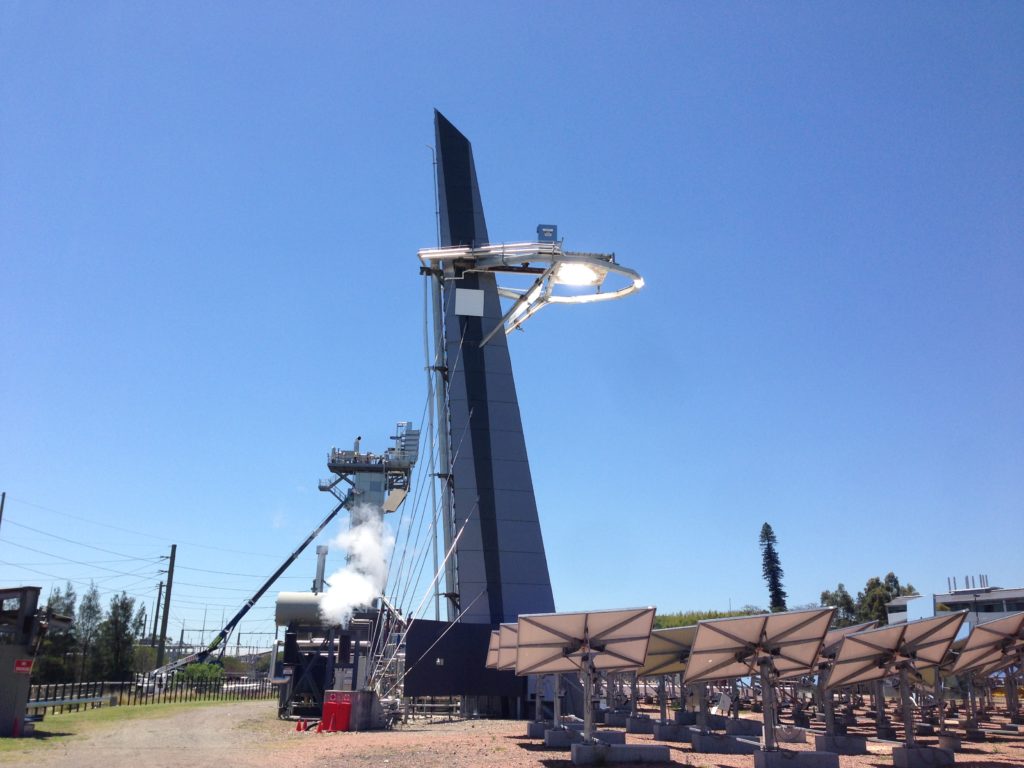
A picture of heliostats.
The Energy Centre heliostat array, taken from Tower 2.
The run of sunny weather we’ve had in south-eastern Australia over the last few weeks has been breaking quite a few records – and not just on the weather charts.
A team of solar thermal engineers and scientists at our Energy Centre in Newcastle have used the ample sunlight flooding their solar fields to create what’s called ‘supercritical’ steam – an ultra-hot, ultra-pressurised steam that’s used to drive the world’s most advanced power plant turbines – at the highest levels of temperature and pressure EVER recorded with solar power.
They used heat from the sun, reflected off a field of heliostats (or mirrors) and concentrated onto a central receiver point to create the steam at these supercritical levels. The achievement is being described in the same terms as breaking the sound barrier, so impressive are its possible implications for solar thermal technology.
So what is it exactly that these Chuck Yaegers of the solar world have gone and done?
A graphic showing a solar thermal power plant works.
How a supercritical solar thermal power plant would work.
Put simply, the temperature of the steam they created (570° C) is about twice the maximum heat of your kitchen oven – or around the point where aluminium alloy would start melting. And the accompanying pressure (23.5 megapascals) is about 100 times as high as the pressure in your car tyres, or roughly what you’d experience if you were about 2 kilometres under the surface of the ocean.
That’s all impressive in itself. But when you take into consideration that this is the first time solar power has ever been used to create these ‘supercritical’ levels on this scale – traditionally only ever reached using the burning of fossil fuels – the real worth of this achievement begins to sink in.
Solar thermal, or concentrating solar power (CSP) power plants have traditionally only ever operated at ‘subcritical’ levels, meaning they could not match the efficiency or output of the world’s most state of the art fossil fuel power plants.

A picture of a solar thermal tower.
The solar thermal tower in action: check out the steam being generated.
Enter our team and their Advanced Solar Steam Receiver Project. To prove that solar thermal technology can match it with the best fossil fuel systems, they developed a fully automated control system which predicts the heat delivered from every mirror (or heliostat), allowing them to achieve maximum heat transfer, without overheating and fatiguing the receiver. With this amount of control, they were able to accurately recreate the temperature and pressures needed for supercritical success.
So instead of relying on burning coal to produce supercritical steam, this method demonstrates that the power plants of the future could be using the zero emission energy of the sun to reach peak efficiency levels – and at a cheaper price.
While the technology may be a fair way off commercial development, this achievement is a big step in paving the way for a low cost, low emission energy future.
The $5.68 million research program is supported by the Australian Renewable Energy Agency and is part of a broader collaboration with Abengoa Solar, the largest supplier of solar thermal electricity in the world.
For media inquiries, contact Simon Hunter – Phone: +61 3 9545 8412 Email: simon.hunter<at>csiro.au



3rd June 2014 at 2:11 pm
Every Government MP needs to see this innovation and get seriously behind efforts to deploy and expand it’s implementation.Our planet can’t wait.I’ve already contacted my MP Alan Tudge.
3rd June 2014 at 2:09 pm
I’m curious if towers like this could concurrently be used for desalination considering they’re boiling water in the process any way? I understand that the salt may have a corrosive effect which would be a deterrent but it seems like the two processes could go easily hand in hand. Are you aware of any research regarding this?
4th June 2014 at 1:17 pm
Hi Talia. I’ll pass this over to one of our scientists working on this project, Mike Collins:
“The water used in steam cycles is very pure and pH controlled to address the corrosion issues that you have mentioned.
However there are some interesting opportunities for combining CSP with desalination. CSIRO is an active member of SolarPACES, who are coordinating a stream of work in this area: http://www.solarpaces.org/tasks/task-vi-solar-energy-and-water-processes-and-applications/concentrating-solar-power-and-desalination-plants
Cheers
Mike”
10th July 2014 at 1:00 pm
Dear Mr. Kachel,
I host and produce a public radio program that airs throughout Southern California on Saturday mornings at 10-11am on Pacifica Radio KPFK 90.7 FM. We produce feature length interviews with authors, inventors, scientists and entrepreneurs. Our most famous guests last year would probably be Former President Al Gore and U.S. Astronaut Buzz Aldrin, but we specifically seek out lesser known equally geeky guests including Dr. Leonard Kleinrock, the UCLA professor who ran the lab at UCLA that sent the first message to Stanford on the ARPANET, the predecessor to the internet.
I read CSIRO’s recent blog post “Our solar team sets a hot and steamy world record” and would like to discuss your achievement of a world record for steam pressure and temperature in your experimental solar thermal power plant.
Best,
Brandon Barney
Producer and Co-Host
Digital Village Radio
Saturdays 10:00-11:00 AM Pacific Time
KPFK/Pacifica (90.7/93.7/98.7/99.5 FM)
Los Angeles/San Diego/Santa Barbara/China Lake
http://www.DigitalCulture.LA.
*********************************************
3rd June 2014 at 2:07 pm
Remind me again why the Federal Government is cutting back on Science?
17th June 2014 at 6:30 am
In a word – Coal
3rd June 2014 at 10:52 am
Amazing stuff. Scientific research like this should be given greater funding.
16th December 2014 at 1:58 pm
I agree
3rd June 2014 at 8:14 am
This is so very exciting I will deferentially be following this technology developments progress. Congratulations CSIRO